Tivadar Csontváry Kosztka
Tivadar Csontváry Kosztka born Mihály Tivadar Kosztka (Hungarian pronunciation: [ˈtivɒdɒr ˈt͡ʃontvaːri ˈkostkɒ]; 5 July 1853 – 20 June 1919) was a Hungarian painter who was part of the avant-garde movement of the early twentieth century.[1] Working mostly in Budapest, he was one of the first Hungarian painters to become known in Europe. He belonged to no specific school of art, but his works included elements similar to those of the foremost painters of Post-impressionism. Many critics consider him Hungary’s greatest painter.[2] On 15 December 2006 the Kieselbach Gallery in Budapest sold an auction the most expensive Csontváry painting so far. The Rendezvous (1902) ("Meeting of the lovers") was bought by an anonymous client for more than one million EUR.
Tivadar Csontváry Kosztka | |
|---|---|
 Self-portrait (around 1900) | |
| Born | 5 July 1853 |
| Died | 20 June 1919 (aged 65) |
| Nationality | Hungarian |
| Known for | Painter |
| Movement | Post-Impressionism, expressionism |
His works are held by the Hungarian National Gallery in Budapest and the Csontváry Museum in Pécs, among other institutions and private collectors.
Biography
Csontváry was born on 5 July 1853 in Kisszeben, Sáros County, Kingdom of Hungary (today Sabinov, Slovakia), and died 20 June 1919 in Budapest. His father, Dr. László Kosztka, was a physician and pharmacist, his mother was Franciska Hajczelmajer of Darócz (now Šarišské Dravce, Slovakia).[3] His ancestors on his father's side were Poles who settled in Hungary.[4] Although Csontváry was obsessed with his Magyar roots, he grew up speaking Slovak mixed with German.[5] He was a pharmacist until his twenties.[6]
On the hot sunny afternoon of 13 October 1880, when he was 27 years old, he had a mystic vision. He heard a voice saying, "You are going to be the greatest painter of the world, greater than Raphael."[7] He took journeys around Europe, visited the galleries of the Vatican, and returned to Hungary to earn money for his journeys by working as an apothecary. From 1890, he traveled around the world. He visited Paris, the Mediterraneum (Dalmatia, Italy, Greece), North Africa and the Middle East (Lebanon, Palestine, Egypt, Syria) and painted pictures. Often his pictures are very large, several meters (yards) wide and height is not unusual.
He painted his major works between 1903 and 1909. He had some exhibitions in Paris (1907) and Western Europe. Most of the critics in Western Europe recognized his abilities, art and congeniality, but in the Kingdom of Hungary during his life, he was considered to be an eccentric crank for several reasons, e. g. for his vegetarianism, anti-alcoholism, anti-smoking, pacifism, and his cloudy, prophetic writings and pamphlets about his life (Curriculum), genius (The Authority, The Genius) and religious philosophy (The Positivum). Some of his biographists considered this as a latent, but increasingly disruptive schizophrenia.[8] Although he was later acclaimed, during his lifetime Csontváry found little understanding for his visionary, expressionistic style. A loner by nature, his "failure" impaired his creative power.
After his death, 42 of Csontváry's paintings lay rolled up, and his heirs almost sold them to be used as cart tarp. They might have been lost forever, if an architect named Gedeon Gerlóczy had not been searching for a studio at the very time and in the very place, stumbling upon the paintings and buying them. For fifty years, these works of art were gathering dust in Gerlóczy's apartment.
He painted more than one hundred pictures, the most famous and emblematic of which is probably The Lonely Cedar (Magányos cédrus). His art connects with post-impressionism and expressionism, but he was an autodidact and cannot be classified into one style. He identified as a "sunway"-painter, a term which he created.
Csontváry and mental disorder
Csontváry is remembered as the “mad painter” in Hungary. Sources, including his own diary indicate that he had suffered from mental disorder at least from the time of his first auditory hallucination experienced at age 27.[7] Many believe that his unique artistic style is a product of his mental difficulties,[9] although opinion is split as to what, if any mental disorder affected the Csontváry and whether that is reflected is his art.[10]
Legacy
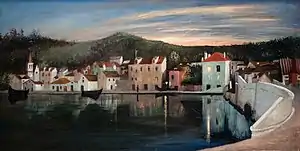
- The Csontváry Museum in Pécs, Hungary, was founded in his honor and holds many of his works.
A quote
- "I, Tivadar Kosztka, who gave up his prime of youth for the rebirth of the world, accepting the call of the invisible Spirit, had a regular civil job, comfort, wealth then (...) Going to Paris in 1907 I oppositely stood alone in front of millions with only the result of the divine providence, and I beat the vanity of the world hollow, but I haven't killed 10 million people, only sobered them, I haven't made commercials from things, because I didn't care for the pedlar's press; I retired from the world instead, going to the top of the Lebanons, and I painted cedars."
- T., Cs. K.: The Positivum.
Gallery
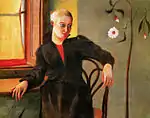 Woman sitting in the window.
Woman sitting in the window..jpg.webp) Deer.
Deer..jpg.webp) Bird of Prey.
Bird of Prey.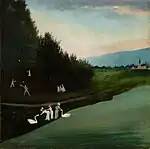 Tennis party.
Tennis party..jpg.webp) People passing a bridge, 1901
People passing a bridge, 1901.jpg.webp) Castellamare di stabia, 1902
Castellamare di stabia, 1902.jpg.webp) Panorama of Selmecbánya
Panorama of Selmecbánya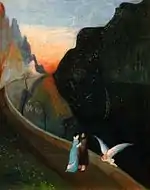 Rendez-vous of Lovers, c. 1902
Rendez-vous of Lovers, c. 1902.jpg.webp) Old Fisherman
Old Fisherman Waterfall at Schaffhausen 1903
Waterfall at Schaffhausen 1903.jpg.webp) Waterfall at Jajce
Waterfall at Jajce.jpg.webp) Tivadar Csontváry Kosztka, painting 1903
Tivadar Csontváry Kosztka, painting 1903.jpg.webp)
.jpg.webp) The praying Prophet (The Young Man from Nain), 1903.
The praying Prophet (The Young Man from Nain), 1903..jpg.webp) The Wailing Wall in Jerusalem, 1904
The Wailing Wall in Jerusalem, 1904.jpg.webp) The Mount of Olives in Jerusalem
The Mount of Olives in Jerusalem.jpg.webp) Pilgrimage to the Cedars in Lebanon, 1907, Hungarian National Gallery, Budapest
Pilgrimage to the Cedars in Lebanon, 1907, Hungarian National Gallery, Budapest.jpg.webp) The Lonely Cedar, 1907, Csontváry Museum, Pécs
The Lonely Cedar, 1907, Csontváry Museum, Pécs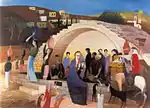 Maria's well in Nazareth
Maria's well in Nazareth The riders at the sea, 1909
The riders at the sea, 1909
References
- Mansbach & V. West 1991, p. 101
- "Tivadar Csontváry-Kosztka | Hungarian artist | Britannica". www.britannica.com. Retrieved 2023-05-27.
- Nemeth, Lajos (1992). Csontvary. Corvina. ISBN 9631326357.
- Valentiner, Wilhelm Reinhold (1965). The Art quarterly. Vol. 28. Detroit Institute of Arts. p. 247.
Tivadar Kosztka — he was a descendant of old Polish aristocracy who settled in Hungary
- The Hungarian quarterly. MTI. 1997. p. 40. Retrieved 20 September 2011.
- Bäckström, Per; Hjartarson, Benedikt (2014). Decentring the Avant-Garde. Rodopi. p. 72. ISBN 978-90-420-3788-5.
- Ustasi, Macar (2010). Csontváry. Pera Müzesi. p. 86. ISBN 978-97-591-2379-6.
- "Csontváry Kosztka Tivadar munkássága a pszichobiográfia tükrében + FOTÓK". Szeged Ma - tények és vélemények. Retrieved 2016-05-24.
- Kővári, Adrienn (23 April 2009). "Amikor megbomlik az összhang". hirextra.hu. Retrieved 17 March 2023.
- Magyar, Hajnalka (8 October 2012). "Czeizel Endre: Csontváry nem volt őrült..." zaol.hu. Archived from the original on 2021-02-26. Retrieved 17 March 2023.
Sources
- Mansbach, Steven A.; V. West, Richard (1991). Standing in the tempest: painters of the Hungarian avant-garde, 1908-1930. Santa Barbara Museum of Art. ISBN 978-0-262-13274-9.
Further reading
- Németh, Lajos. Csontváry. Budapest: Corvina, 1992. ISBN 963 13 2635 7.
External links
- An extremely high-res photo of painting Ruins of Greek Theatre at Taormina (courtesy of Hungarian National Gallery)
- Csontváry Museum, Pécs (after first switching to English)
- Fine Arts in Hungary
- Short biography
- Csontváry (1980) at IMDb
- Csontvary on the Oceanbidge
- Csontvary in Encyclopedia - Britannica Online Encyclopedia
- Csontváry Geniusz exhibition in Budapest, 2015